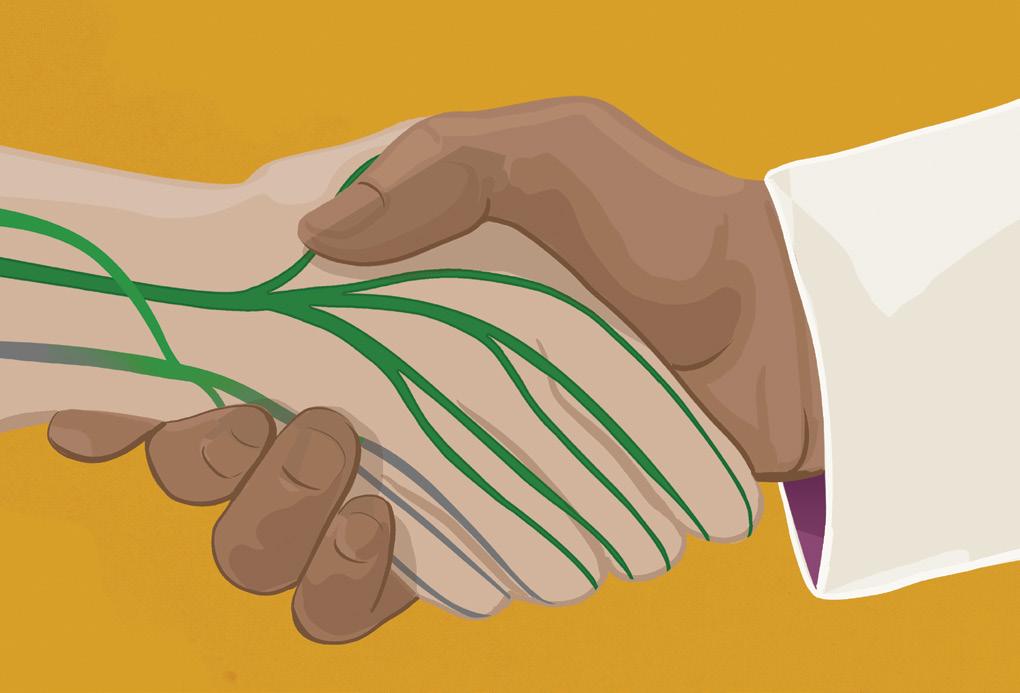Try GOLD - Free
Nerves Do Regenerate
Scientific American
|September 2025
Neurons, once thought to be irreparable, can grow anew—even in the brain

BILLIONS OF NERVE CELLS send signals coursing through our bodies, serving as conduits through which the brain performs its essential functions. For millennia physicians thought damage to nerves was irreversible. In ancient Greece, founders of modern medicine such as Hippocrates and Galen refused to operate on damaged nerves for fear of causing pain, convulsions or even death.
The dogma stood relatively still until the past two centuries, during which surgeons and scientists found evidence that neurons in the body and brain can repair themselves and regenerate after injury and that new nerve cells can grow throughout the lifespan. In recent decades this knowledge has inspired promising treatments for nerve injuries and has led researchers to investigate interventions for neurodegenerative disease.
In humans and other vertebrates, the nervous system is split into two parts: the central nervous system, composed of the spinal cord and brain, and the peripheral nervous system, which connects the brain to the rest of the body.
Attempts to suture together the ends of damaged neurons in the peripheral nervous system date back to the seventh century. It was only in the late 1800s, however, that scientists began to understand how, exactly, nerves regenerate. Through his experiments on frogs, British physiologist Augustus Waller described in detail what happens to a peripheral nerve after injury. Then, in the 1900s, the influential Spanish neuroanatomist Santiago Ramón y Cajal provided insight into how nerve regeneration occurs at the cellular level. Still, there remained fierce debate about whether stitching nerves together would harm more than help.
This story is from the September 2025 edition of Scientific American.
Subscribe to Magzter GOLD to access thousands of curated premium stories, and 10,000+ magazines and newspapers.
Already a subscriber? Sign In
MORE STORIES FROM Scientific American
Scientific American
Will We Run Out of Rare Earth Elements?
These valuable but difficult-to-extract metals are increasingly important to modern life
1 mins
December 2025

Scientific American
Copyright Laws Can Stop Deepfakes
The U.S. should give its residents rights to their own face and voice
4 mins
December 2025

Scientific American
50, 100 & 150 Years
“The list of first-aid procedures that the medical profession encourages laypeople to undertake is short because of concern that tactics applied in ignorance may do more harm than good.
3 mins
December 2025

Scientific American
Dramatic Atmosphere
Exoplanet TOI-561 b has air where none should persist
2 mins
December 2025

Scientific American
The Mother of Depressions
Postpartum depression is a leading cause of death among new mothers. A new type of drug offers better, faster treatment
16 mins
December 2025

Scientific American
Going Rogue
A massive study may improve the prediction of dangerous rogue waves
3 mins
December 2025

Scientific American
Phages Caught Sleeping
Bacteria use hibernating viruses to immunize themselves
2 mins
December 2025
Scientific American
THE COVERT HERBARIUM OF CRYPTOGAMIC BOTANY
A century ago a father and a son labored to replicate the intricate structure of nearly eight hundred species of plants in four thousand delicate models.
1 min
December 2025

Scientific American
Are AI Chatbots Healthy for Teens?
Kids crave approval from their peers. Chatbots offer an alternative to real-life relationships, but they can come at a price
5 mins
December 2025

Scientific American
The Myth of the Designer Baby
Parents beware of any genomics firm saying it can help them with “genetic optimization” of their embryos
5 mins
December 2025
Listen
Translate
Change font size

